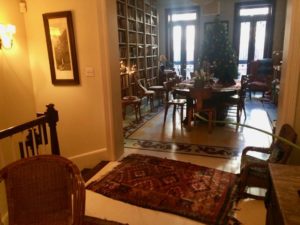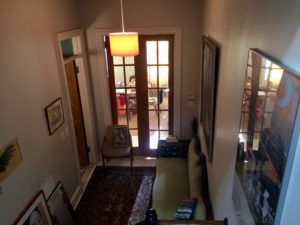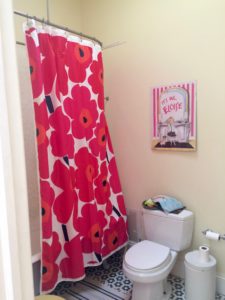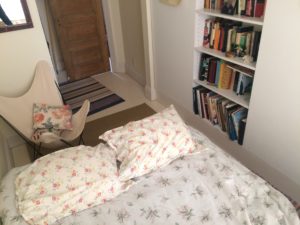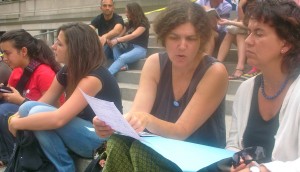Program Description
HUMANITIES SPRING IN NEW YORK (HSNY) is a full-immersion, travel-study program, with its home-base in a beautiful, 4-story townhouse in Manhattan. Students have 4 hours of morning classes and then we spend the rest of the day together exploring the city in English, of course! A typical day at HSNY goes from 9:00 a.m. to 7:30 pm. The afternoon trips and excursions are an integral part of the course. For example, when we go to see Ground Zero together, each student writes a 3-4-line composition (some students write much more!) about their individual reactions to this impressive and moving monument. While you are writing your compositions, HSNY Teachers will help you to understand and correct your mistakes; then each student reads his or her composition out loud to the rest of the group. Memorization is also an important part of the HSNY experience. More advanced students will memorize their entire composition before sharing it out loud with others, some students memorize just the first sentence and then read the rest. Memorization is important at HSNY because we find it helps you to make new vocabulary and syntax a part of your long-term memory and help you to generate new more complex sentences in the future.
And off we go to discover the city and to talk about what we see together in English. English all day long from 9:00 to 7:30, both inside and outside the classroom. The Metropolitan Museum of Art, baseball, the Circle Line Cruise, Central Park. Chinatown, the Empire State Building, Brooklyn Bridge, Lincoln Center Out-of-Doors Festival, Harlem Gospel, Shakespeare in the Park, Ground Zero, The High Line, The Museum of the City of New York, the Stardust Diner, and the skyscrapers themselves — all this and our reactions to it become our HSNY English Course, our HSNY textbooks.
- Discussing paintings (in English!!) at the MoMA
- I love Jasper Johns!
Our home-base is in Manhattan, but together we will get to know the four other boroughs as well: The Brooklyn Promenade, The Staten Island Ferry and Chinese Scholars Garden, The Queens Museum and Park and most years, the Bronx Zoo. Students have four hours of interactive lessons (the method is very much American!) and then the rest of the day is spent discovering this magnificent city, capital of experimentation both in art and in life!
Wherever we go, conversation between students and staff is at the heart of the HSNY experience. We reflect on, write and talk about what we’ve seen and experienced together. And we chat in English; sometimes staff will correct your every mistake to help you improve your mastery and pronunciation; sometimes we will not correct you at all to encourage you to express yourself freely and increase your fluency; both aspects are equally important. This is the intensive, communal English course that is Humanities Spring in New York.
Home-base:
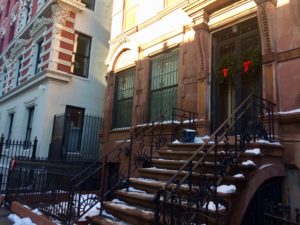
House from outside
We have finally found a beautiful house right in Manhattan which is well connected to both to city buses and the subway. The buses are more scenic; the subway faster, so we use both in our travels around the city. We also do a lot of walking as a group. The house has beautiful public spaces including a garden (where we will often have dinner), a large kitchen with two tables and a sofa, a living room and an enormous dining room. The house has no less than four bathrooms! There is a piano for yours to play, and a laundry room with both washer and dryer.
The bedrooms are charming; there are three double rooms and one very large room that sleeps six.
The house is sunny, quiet, and very comfortable, decorated in a whimsical New York style we think you will all delight in.
- Living Room
- Dining room from living room
- Kitchen and view of the garden
- Stairs from third floor to second floor
- Bathroom
- Bedroom 2 upstairs
Our bus is the M103; our subways the A, D, and C (which are very close). The 1, 2, 3 are also closely. The nearest subway stop is also an express stop which means we can make it to 59th street (from 122nd) in less than 10 minutes. A New York miracle! The bus-stop is right around the corner.
We are very near Central Park, with lots of little cafés and typical NYC restaurants as well as lots of little charming shops, both boutiques and larger stores. We will do our shopping in a New York supermarket with an excellent line of organic products, and when we feel like it, we will adventure our way to Fairways, a famous NYC institution, just a little further away.
But we will also have coffee or a glass of wine together at funky East Village coffee shops, at 19th-century frescoed cafés just off Washington Square, or at the Met’s Rooftop Café, with its views of the city skyline and its contemporary American sculptures. We will talk together about this and that and about what has struck us most during the day. Slowly you will begin to discover the city for yourselves — its clubs, cafés, and restaurants of all sorts.
Meals:
Breakfast (from Mondays to Saturdays) is included for everyone. As for the other meals, we offer 3 meal plan options:
- Meal Plan A: 6 breakfasts (included for everyone) + Sunday Brunch + 5 lunches = 35 euros a week;
- Meal Plan B: 6 breakfasts (included for everyone) + Sunday Brunch + 5 lunches + 2 dinners (to be booked the day before by 9 p.m.) = 50 euros a week;
- Meal Plan C: 6 breakfasts (included for everyone) + Sunday Brunch + 4 dinners (on Monday, Tuesday, Thursday and Friday) = 60 euros a week.
Our directors
Jane Oliensis was born in New York City and got her degrees at Harvard and Columbia Universities. She has published poems and translations both in Italy and the United States and lectured on literary subjects on both sides of the Atlantic. Professor Oliensis has taught a wide range of courses in Italy, including two of her favorites, A History of Anglo-American Literature, from Anglo-Saxon Riddle Poems to Marianne Moore, and a seminar on Becoming New York City. Professor Oliensis taught for several years at the Università di Perugia, in the Facoltà di Scienze Lingustiche. She left the University in 2007 to devote herself exclusively to Humanities Spring. She founded Humanities Spring in 1991. She agrees with Horace that all true learning should teach and delight students. Professor Oliensis lives in the hills outside Assisi with her family, one charming dog, and a lot of cats.
Marinella Caputo, professor, curator, and critic, got her degrees in Classical Archaeology and teaches Art History at the Liceo Artistico di Perugia. She has done research in archeology and art history (from classical to contemporary) and is widely published in scholarly journals, art reviews, and catalogues. Specialized for the last twenty years in the contemporary, Professor Caputo has curated exhibits of contemporary art all over Italy, and lectured on contemporary themes at universities and cultural institutes both in Italy and abroad. She encourages creativity in her students, and believes it is important for teachers and students alike to be continually inspired by the art and architecture they see – both in their work and in their lives. She has taught classes in Italian, archaeology, translation, and art history at Humanities Spring for over 20 years.




